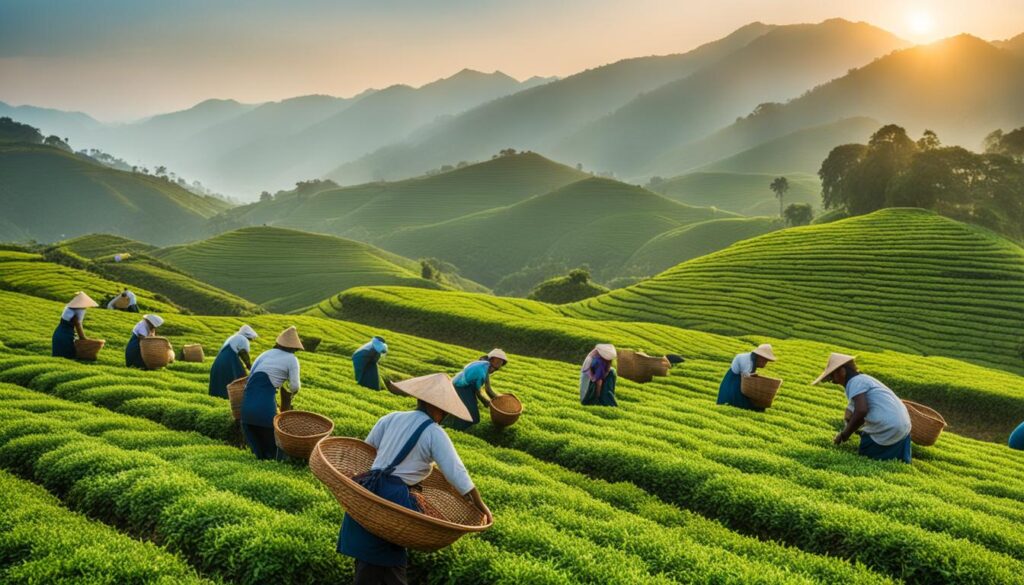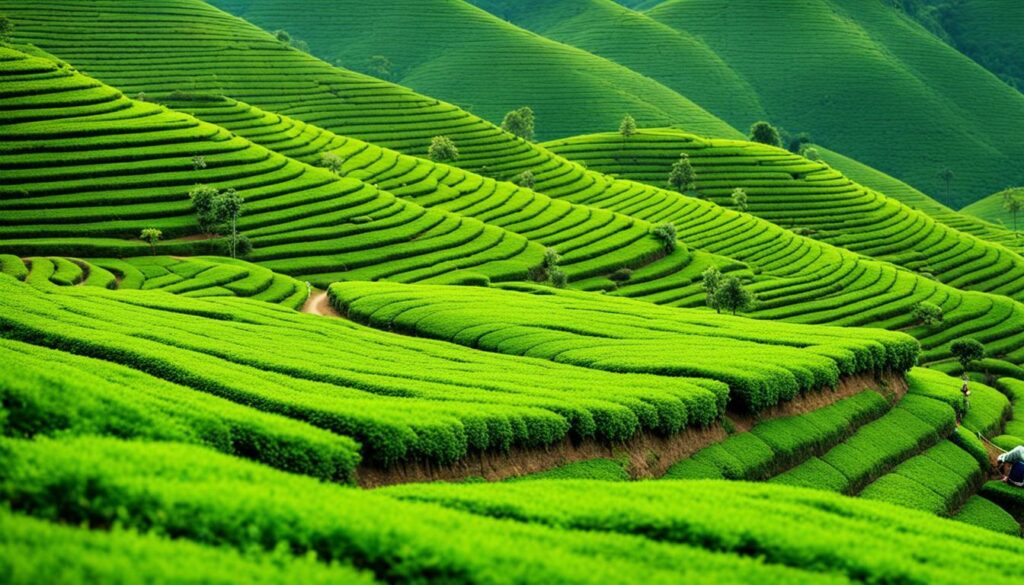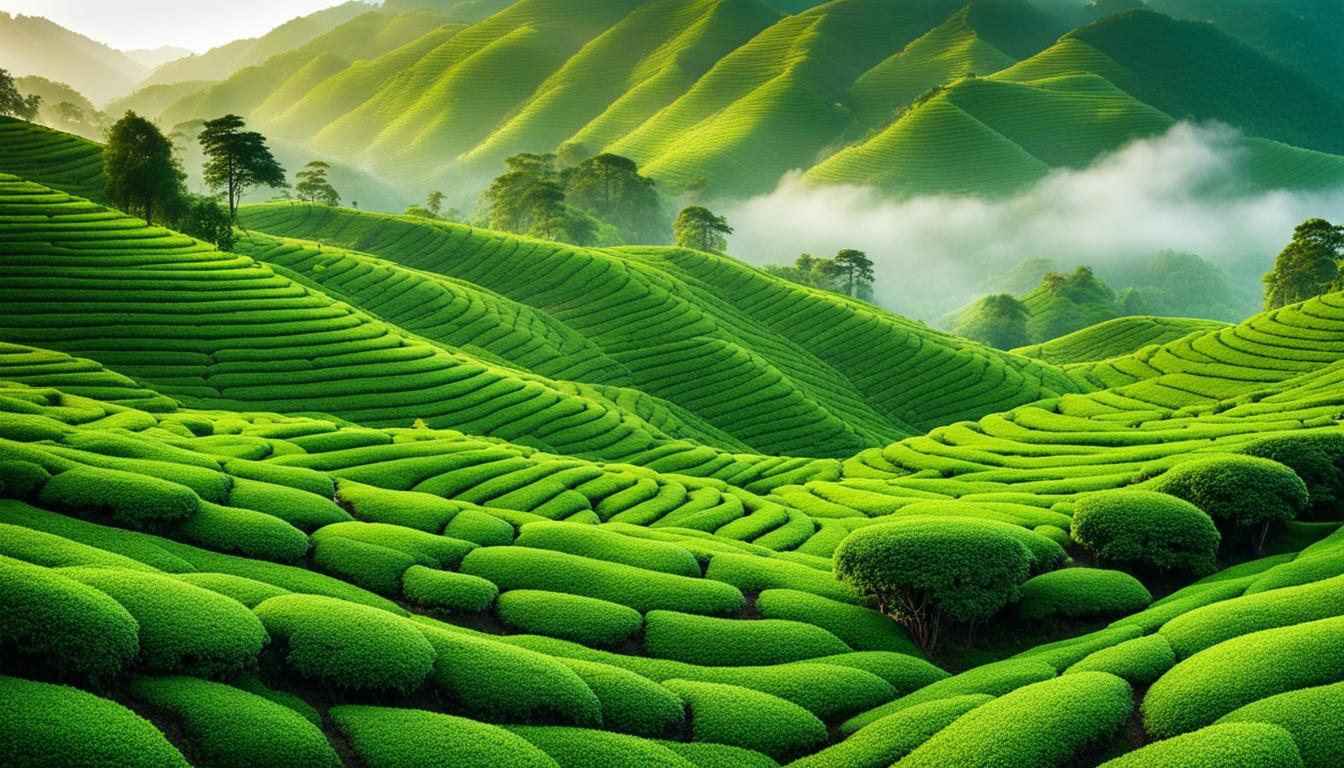Tea cultivation has a long and fascinating history in China, India, and Sri Lanka. From ancient tea trade routes to the modern-day tea industry, these countries have played a significant role in shaping the world of tea. Let’s journey back in time and explore the origins of tea farming in Asia and the impact it has had on these nations.
Key Takeaways:
- Tea cultivation has a rich history in China, India, and Sri Lanka.
- China’s Shang dynasty was the earliest recorded account of tea drinking.
- The British introduced commercial tea production in India and Sri Lanka.
- Tea plays a significant role in the culture and economy of these countries.
- Technological advancements have revolutionized tea cultivation.
Tea Cultivation in China
Tea cultivation in China has a long and fascinating history that spans thousands of years. From its humble beginnings as a medicinal drink during the Shang dynasty, tea has evolved into a beloved beverage deeply ingrained in Chinese culture. The Chinese have perfected the art of tea cultivation, resulting in a wide variety of flavors and high-quality standards that have captivated tea enthusiasts around the world.
The development of the tea industry in China has been marked by constant innovation and improvement. The Chinese have embraced modern technologies while still preserving traditional tea plantation practices. This combination of ancient wisdom and modern techniques has led to increased productivity and enhanced the overall quality of Chinese teas.
The rich history of tea in China has also had a significant influence on the evolution of the tea industry in other countries, such as India. The British, who were avid tea drinkers, introduced tea plantations to India during their colonial rule. They brought tea plants from China, primarily the Assamica variety, and established tea cultivation in the Assam region. This marked the beginning of Indian tea production and laid the foundation for the country’s flourishing tea industry.
The Historical Evolution of Indian Tea
Indian tea has its own distinct characteristics and flavor profiles, thanks to the unique soil and climatic conditions in different tea-growing regions. Over the years, Indian tea plantations have adopted various cultivation methods and practices to meet the growing demand for tea. The Indian tea industry continues to thrive, with its teas being highly sought after in both domestic and international markets.
| Tea Region | Notable Characteristics |
|---|---|
| Assam | Strong, malty flavors |
| Darjeeling | Light and floral with muscatel notes |
| Nilgiri | Fragrant and brisk |
The historical evolution of Indian tea showcases the resilience and adaptability of tea cultivation. Despite facing challenges such as changing government policies and weather conditions, the Indian tea industry has remained a major player in the global tea market. Its contribution to the economy and the livelihoods of those involved in tea production and trade cannot be overstated.
Tea Cultivation in India
Tea cultivation in India has a fascinating history, with its roots dating back to the 19th century during British colonial rule. The British introduced the tea plant, specifically the Assamica variety, which thrived in the plains of Assam. The favorable climate and rich soil in this region provided ideal conditions for tea cultivation. As a result, tea plantations were established, and the industry quickly replaced the declining coffee industry in India.
In addition to the plains of Assam, tea cultivation also expanded to the picturesque Darjeeling region. The high altitude and unique climatic conditions in Darjeeling contribute to the distinctive flavor profile of the tea grown there. Darjeeling tea has gained worldwide recognition for its exquisite taste and is often referred to as the “Champagne of Teas.”
The growth of the tea industry in India has led to the adoption of various cultivation methods and practices over the years. From traditional hand plucking to the use of machinery, Indian tea plantations have evolved to meet the growing demand for tea. These advancements have not only increased productivity but also helped maintain the quality and flavor of Indian teas.

Influence of Indian Tea on the Global Market
Indian tea has made a significant impact on the global market, with its unique characteristics and flavors appealing to tea enthusiasts worldwide. The country’s diverse tea production includes Assam tea, Darjeeling tea, and Nilgiri tea, each with its own distinct taste and aroma. The teas are known for their robust flavors and are often enjoyed with milk and sugar, making them popular choices for blends and chai preparations.
India is one of the largest tea producers globally, exporting large quantities of tea to countries around the world. Its teas are highly sought after, and Indian tea auctions, particularly in Kolkata, play a crucial role in the trade and distribution of teas. The economic impact of tea cultivation in India is significant, providing employment opportunities and contributing to the country’s economy.
Overall, tea cultivation in India continues to thrive, providing consumers with a wide range of quality teas while contributing to the rich tapestry of the global tea industry.
Tea Cultivation in Sri Lanka
Sri Lanka, formerly known as Ceylon, has a long and fascinating history of tea cultivation. The British introduced tea plantations to the island in the 19th century, which quickly replaced the declining coffee industry. The highland region of Kandy, with its rich soil and favorable climate, became a major tea-growing area.
The tea industry in Sri Lanka has faced challenges over the years, including government policies and weather conditions. However, it has remained a significant contributor to the global tea market and continues to produce high-quality teas. The growth of the tea industry in Sri Lanka has had a positive impact on the country’s economy, providing employment opportunities and generating revenue through international trade.
To showcase the importance of tea cultivation in Sri Lanka, here is a table summarizing key data on the tea industry’s growth in major countries:
| Country | Tea Production (in metric tons) | Top Tea Exporters | Consumption Per Capita |
|---|---|---|---|
| Sri Lanka | 327,500 | United Arab Emirates, Iraq, Russia | 1.2 kg |
| India | 1,339,000 | Russia, United States, United Kingdom | 0.84 kg |
| China | 2,600,000 | Russia, Pakistan, United Kingdom | 0.38 kg |
Source: Tea Board of India, China Tea Marketing Association, Sri Lanka Tea Board
Tea Farming History in Sri Lanka
The tea farming history in Sri Lanka dates back to the 1860s when British planters introduced tea plantations to the country. The decline of the coffee industry, mainly due to the coffee leaf rust epidemic, paved the way for the flourishing tea industry. The favorable climate and rich soil of the highland regions, such as Kandy and Nuwara Eliya, proved ideal for tea cultivation.
Sri Lanka’s unique teas, including Ceylon black tea and aromatic teas from the hill country, have gained international recognition for their distinct flavors and quality. The country’s tea industry has also embraced sustainable farming practices, with many plantations adopting organic and eco-friendly cultivation methods.
“The tea industry in Sri Lanka has a rich history and continues to be a significant contributor to the global tea market, offering a wide range of high-quality teas.” – Tea Expert
The Cultural Significance of Tea in China, India, and Sri Lanka
Tea holds a deep cultural significance in China, India, and Sri Lanka, shaping traditions, customs, and social gatherings. Throughout history, tea has been more than just a beverage—it has served as a symbol of hospitality, social connection, and mindfulness.
China’s Ancient Tea Trade Routes
China has a long and rich history of tea cultivation and trade. Ancient tea trade routes connected China with countries like India, facilitating the exchange of tea, knowledge, and culture. These trade routes played a crucial role in the spread of tea cultivation and tea culture across Asia. The Silk Road, for example, not only facilitated the trade of silk, but it was also a major artery for the tea trade, connecting China with Central Asia, the Middle East, and Europe.
The Chinese tea ceremony, known for its meticulous preparation and presentation, reflects the deep respect and reverence for tea. It is an art form that embodies harmony, balance, and mindfulness, inviting participants to savor each sip and appreciate the moment. The tea ceremony has become an integral part of Chinese cultural heritage and is still practiced today.
Quote: “Tea is liquid wisdom.” – Anonymous
India’s Tea Cultivation Milestones
In India, tea has become the most popular beverage, deeply rooted in the country’s culture and daily life. The British introduced tea cultivation to India during colonial rule, and it quickly became a thriving industry. Today, India is one of the world’s largest tea producers and exporters.
India has developed unique tea traditions, such as masala chai—a blend of tea, milk, and spices—and the famous tea auctions held in Kolkata. These auctions are renowned for their lively bidding process and showcase the diverse range of teas produced in India. They attract buyers from all over the world, further cementing India’s position as a key player in the global tea market.
Sri Lanka’s Tea Heritage
In Sri Lanka, tea is celebrated for its flavor, quality, and scenic tea plantations. The British introduced tea cultivation to Sri Lanka after the decline of the coffee industry. Today, tea has become an essential part of the country’s economy and landscape.
The highland region of Kandy in Sri Lanka is known for its tea-growing areas and picturesque landscapes. The tea plantations not only provide employment opportunities for local communities but also attract tourists who are fascinated by the tea production process and the stunning vistas.
The cultural significance of tea in China, India, and Sri Lanka is deeply embedded in the traditions and customs of these countries. Whether it’s the ancient trade routes of China, the diverse tea traditions of India, or the scenic tea plantations of Sri Lanka, tea continues to be cherished and celebrated for its cultural, social, and economic contributions.
Technological Advancements in Tea Cultivation
As the global demand for tea continues to grow, the tea industry in major tea-producing countries like China, India, and Sri Lanka has embraced technological advancements to meet this increased demand. These advancements have revolutionized tea cultivation practices and have had a significant impact on productivity, quality, and sustainability.
Technological Innovations in China
In China, traditional tea plantation practices have been combined with modern techniques to optimize efficiency and enhance the overall quality of tea production. The use of remote sensing technologies, such as drones and satellites, has revolutionized farming practices by providing valuable data on soil conditions, plant health, and irrigation needs. This data-driven approach allows farmers to make informed decisions and improve the overall management of tea plantations.
“By leveraging technology, tea farmers in China have been able to enhance productivity and ensure the consistency of tea quality.”
Furthermore, the use of automated tea processing machinery has streamlined the production process, eliminating manual labor and reducing the risk of human error. These machines are capable of plucking tea leaves, processing them, and sorting them based on quality standards. The automation of tea processing not only ensures a more efficient workflow but also maintains the integrity of the tea leaves, resulting in higher-quality teas.
Technological Advancements in India and Sri Lanka
In India, the use of machinery and automation has transformed tea processing operations, enabling large-scale production to meet the growing demand for tea. Automated tea processing machines have replaced manual labor in tasks such as withering, rolling, and drying, improving efficiency and consistency. Additionally, the adoption of modern irrigation techniques, such as drip irrigation, has optimized water usage and enhanced the sustainability of tea cultivation.
Sri Lanka has also embraced technological advancements in tea cultivation, particularly in the areas of tea leaf plucking and processing. Mechanized tea pluckers, equipped with rotating blades, have replaced traditional hand plucking, increasing efficiency and reducing labor costs. Advanced tea processing machinery, including withering troughs, rolling tables, and drying machines, have improved tea quality and reduced processing time.
The Economic Impact of Tea Cultivatio
Tea cultivation in China, India, and Sri Lanka has a significant impact on the economies of these countries. The tea industries provide employment opportunities for thousands of people, contributing to economic growth and development. The growth of the tea industry in these major tea-producing countries has also spurred international trade, generating revenue through tea exports.
In China, as the largest tea producer in the world, the tea industry plays a vital role in the global tea market. The development of the tea industry in China has led to increased production and trade, creating a booming market for Chinese teas. The economic impact of tea cultivation extends to India and Sri Lanka as well. Both countries have established themselves as major players in the global tea market and have seen significant growth in tea exports.
According to the latest market research, the global tea industry is expected to continue its growth trajectory in the coming years. The increasing demand for tea, both domestically and internationally, contributes to the economic stability of tea-producing countries. The development of the tea industry in China, alongside the growth of the industry in India and Sri Lanka, has fostered economic opportunities and improved the livelihoods of those involved in tea production and trade.

The Economic Impact of Tea Cultivation in China, India, and Sri Lanka
| Country | Tea Production (in metric tons) | Tea Exports (in metric tons) | Revenue from Tea Exports (in millions USD) |
|---|---|---|---|
| China | 2,800,000 | 325,000 | 2,500 |
| India | 1,350,000 | 270,000 | 800 |
| Sri Lanka | 320,000 | 280,000 | 1,100 |
The table above highlights the tea production, tea exports, and revenue from tea exports in China, India, and Sri Lanka. These figures demonstrate the significant economic impact of tea cultivation in these countries. The revenue generated from tea exports contributes to the economies of these nations, supporting infrastructure development, healthcare, education, and other vital sectors.
Conclusion
Tea cultivation in China, India, and Sri Lanka has a fascinating history that spans centuries. From its origins as a medicinal drink in ancient China to its global popularity today, tea has shaped the cultures and economies of these nations.
The historical tea plantation practices in these countries have laid the foundation for the diverse tea varieties and flavors we enjoy today. China, with its rich tea cultivation history, continues to produce high-quality teas that are revered worldwide. India, known for its Assam and Darjeeling teas, has become a major player in the global tea market. And Sri Lanka, once a thriving coffee industry turned tea powerhouse, offers flavorful teas that captivate tea enthusiasts.
As technology has advanced, tea cultivation has embraced modern techniques, resulting in increased productivity and efficiency. The economic impact of tea cultivation is significant, providing employment opportunities and contributing to the economies of these countries.
In conclusion, the rich tapestry of tea cultivation in China, India, and Sri Lanka showcases the historical, cultural, and economic significance of this beloved beverage. As tea continues to evolve and adapt, the traditions and heritage of tea cultivation remain at the heart of this timeless industry.
FAQ
What is the history of tea cultivation in China, India, and Sri Lanka?
Tea cultivation has a long and rich history in China, India, and Sri Lanka. It originated in China during the Shang dynasty and later spread to India and Sri Lanka through ancient trade routes.
How did tea cultivation begin in China?
Tea drinking in China started during the Shang dynasty for its medicinal properties, and it later gained popularity as a beverage. The Chinese have been cultivating tea for thousands of years, making it an integral part of their culture.
When did tea cultivation start in India?
Tea cultivation in India began during British colonial rule in the 19th century. The British introduced the tea plant from China, specifically the Assamica variety, which thrived in the plains of Assam.
How did tea cultivation begin in Sri Lanka?
Tea cultivation in Sri Lanka started after the decline of the coffee industry due to the coffee leaf rust epidemic. The British introduced tea plantations to the island, and it quickly became a thriving industry.
What is the cultural significance of tea in China, India, and Sri Lanka?
Tea holds immense cultural significance in these countries. It has been a part of daily life in China for centuries, while in India it is the most popular beverage and an integral part of social gatherings. In Sri Lanka, tea is celebrated for its flavor and quality.
What are the technological advancements in tea cultivation?
Over the years, traditional tea plantation practices have been combined with modern techniques in China, India, and Sri Lanka. This includes the use of machinery for plucking and processing tea leaves, resulting in increased efficiency and productivity.
What is the economic impact of tea cultivation?
The tea industries in China, India, and Sri Lanka provide employment opportunities and contribute to the economies of these countries. Tea exports generate revenue through international trade, making these countries major players in the global tea market.
What is the conclusion of the history of tea cultivation?
Tea cultivation in China, India, and Sri Lanka has a rich and ancient history. It has shaped the societies and economies of these nations, with each country contributing unique flavors and varieties to the global tea industry.





